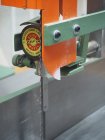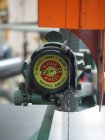I got the Ball bearing type. They came stacked so that I can run wide blades as well.Carter makes several styles of guides, which ones did you get, Ball-bearing, Guidall, or Micro-Precision ones?
-
Beware of Counterfeit Woodturning Tools (click here for details) -
Johnathan Silwones is starting a new AAW chapter, Southern Alleghenies Woodturners, in Johnstown, PA. (click here for details) -
Congratulations to Keven Jesequel for "Big Leaf Maple" being selected as Turning of the Week for April 15, 2024 (click here for details) -
Welcome new registering member. Your username must be your real First and Last name (for example: John Doe). "Screen names" and "handles" are not allowed and your registration will be deleted if you don't use your real name. Also, do not use all caps nor all lower case.
You are using an out of date browser. It may not display this or other websites correctly.
You should upgrade or use an alternative browser.
You should upgrade or use an alternative browser.
Bandsaw Blade Guides
- Thread starter Donovan Bailey
- Start date
Sirs: As stated above, I owe you some feedback on the Carter guides. I have really put them through their paces. I've cut a ton of various dry and wet timber since installing them on my bandsaw and I'm here to report that I am completely happy with their performance. On the plus side: 1) The amount of tinkering/adjustments I've had to do with them before I use the saw is at a minimum; 2) I've not had a significant sludge buildup on the bearings from wet work; 3) Installation and any adjustments are really easy. On the minus side: 1) They are expensive (but worth every penny as far as I'm concerned).. I agree with Gerald above in that my only regret is that I didn't install them when I initially bought the bandsaw.
Roger Wiegand
Beta Tester
I put Carter guides on my 14" Delta saw about 25 years ago (back before cool blocks and such existed). Haven't yet had any reason to regret it. I hated the guides that came with the saw, but can't really remember why any more.
Hi all, This is my first post. Haven't had time to post a picture yet and my left arm is in a cast anyway. Please don't ask.
Anyway has has been mentioned Carter has several types of guides. The Guidall versions may have trouble with wet wood as it gets jammed between the rollers and the blade. I have been using Microprecision 20's on my saw for 25 years. Nothing and I do mean nothing bothers them. I have replaced the guide blocks once and I resurface them on a lapping plate every several years or so. Adjusting them correctly can be a PITA but once locked in they stay there. First tension your blade and have it running where your like it. The easiest way to adjust them I've found to be with feeler gauges. I put a 0.003" feeler gauge on each side of the blade along the longitudinal blade axis behind the gullets between the blade and the guide blocks. Then I adjust the guide blocks down tight and remove the gauges. The trick is in keeping the blade centered and the front edge of the blocks right at the rear edge of the gullets. Adjust the thrust bearings so the they just barely touch the blade. When you start the saw the blade should just nick the thrust bearings
 then when you apply pressure on the blade with wood please the thrust bearings should immediately spin up making a wonderful symphony. I keep a 1/2 inch Lenox blade in the saw at all times. I do have 1/4 inch blades and a 3/4" carbide blade but I rarely use them. For tight curves I use a scroll saw on wood up to 1/2" thick. Always be sure to check the lead of the blade and adjust your fence to it or the blade will wander on cuts over two inches thick. I have resawed planks 14" wide with a 1/2" blade no problem. Just slow.
then when you apply pressure on the blade with wood please the thrust bearings should immediately spin up making a wonderful symphony. I keep a 1/2 inch Lenox blade in the saw at all times. I do have 1/4 inch blades and a 3/4" carbide blade but I rarely use them. For tight curves I use a scroll saw on wood up to 1/2" thick. Always be sure to check the lead of the blade and adjust your fence to it or the blade will wander on cuts over two inches thick. I have resawed planks 14" wide with a 1/2" blade no problem. Just slow.
Anyway has has been mentioned Carter has several types of guides. The Guidall versions may have trouble with wet wood as it gets jammed between the rollers and the blade. I have been using Microprecision 20's on my saw for 25 years. Nothing and I do mean nothing bothers them. I have replaced the guide blocks once and I resurface them on a lapping plate every several years or so. Adjusting them correctly can be a PITA but once locked in they stay there. First tension your blade and have it running where your like it. The easiest way to adjust them I've found to be with feeler gauges. I put a 0.003" feeler gauge on each side of the blade along the longitudinal blade axis behind the gullets between the blade and the guide blocks. Then I adjust the guide blocks down tight and remove the gauges. The trick is in keeping the blade centered and the front edge of the blocks right at the rear edge of the gullets. Adjust the thrust bearings so the they just barely touch the blade. When you start the saw the blade should just nick the thrust bearings

 then when you apply pressure on the blade with wood please the thrust bearings should immediately spin up making a wonderful symphony. I keep a 1/2 inch Lenox blade in the saw at all times. I do have 1/4 inch blades and a 3/4" carbide blade but I rarely use them. For tight curves I use a scroll saw on wood up to 1/2" thick. Always be sure to check the lead of the blade and adjust your fence to it or the blade will wander on cuts over two inches thick. I have resawed planks 14" wide with a 1/2" blade no problem. Just slow.
then when you apply pressure on the blade with wood please the thrust bearings should immediately spin up making a wonderful symphony. I keep a 1/2 inch Lenox blade in the saw at all times. I do have 1/4 inch blades and a 3/4" carbide blade but I rarely use them. For tight curves I use a scroll saw on wood up to 1/2" thick. Always be sure to check the lead of the blade and adjust your fence to it or the blade will wander on cuts over two inches thick. I have resawed planks 14" wide with a 1/2" blade no problem. Just slow.Before there were 'Cool Blocks' there was Lignum Vitae blocks.... That was before my time though...
robo hippy
robo hippy
I have not tried the other blocks besides the metal ones that come with the guides. I can't imagine they would last longer.
Thanks for the feedback. My new guides are scheduled to arrive today. Do you cut blanks on your saw? If so, do the Carter bearings do the job...or do you have to continually fiddle with them to make them work on blanks?
I've been using the carter guides for several years. Almost all of my work is rounding green bowl blanks. I think the guides are great. After adjustment, I don't mess with them unless I'm changing blades or the top thrust bearing grub screw backs out. I use DNA and a green pad to scrub off the gunk every couple of months. On my grizzly 555 I've found that the grub screw on the top thrust bearing tends to work itself loose. A dab of threadloc or some cheap enamel nail polish fixes that.
The metal used for the guide blocks is quite soft and sort of greasy. I'm not sure but they may be doing this to for noise, safety and or lubricity. I spray the blade and blocks with GlideCote once in a while but they still wear, more so if they are not adjusted just right. When they become notched by the blade I lap them on 220 grit silicone carbide paper with oil. The paper is cemented to a 1/2" thick glass plate (dead flat). You can do this 3-4 times before they have to be replaced.
You have to be careful with the Loctite. It comes in three strengths, Low, medium and High. Use the Low only or you will have to take a torch to the screw to loosen it. It is a great recommendation however as bandsaws do vibrate and the thrust bearing takes a lot of punishment. It is the only set screw that has come loose and there must be 10 on each guide.
If the thrust bearing becomes loose the blade will slide back in the blocks and the kerf will chew them up beyond repair.
Another factor is the quality of the blade weld. If it is stepped in any way you get thunk, thunk, thunk and this wears the guide blocks and thrust bearing faster not to mention being very annoying. A smooth running bandsaw is a thing to behold.
You have to be careful with the Loctite. It comes in three strengths, Low, medium and High. Use the Low only or you will have to take a torch to the screw to loosen it. It is a great recommendation however as bandsaws do vibrate and the thrust bearing takes a lot of punishment. It is the only set screw that has come loose and there must be 10 on each guide.
If the thrust bearing becomes loose the blade will slide back in the blocks and the kerf will chew them up beyond repair.
Another factor is the quality of the blade weld. If it is stepped in any way you get thunk, thunk, thunk and this wears the guide blocks and thrust bearing faster not to mention being very annoying. A smooth running bandsaw is a thing to behold.
Use the Low only or you will have to take a torch to the screw to loosen it.
That was a hard lesson I learned in the Navy.
The first time I found that screw on the table I put it back in, then checked every one of them and added loctite.
